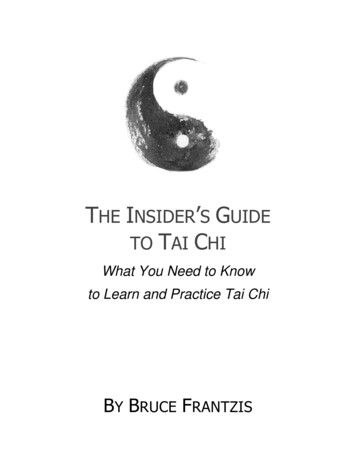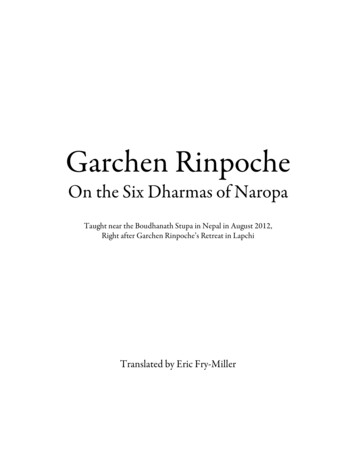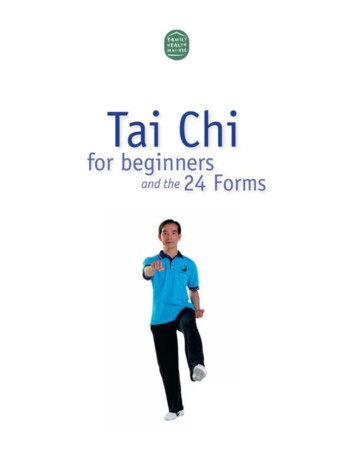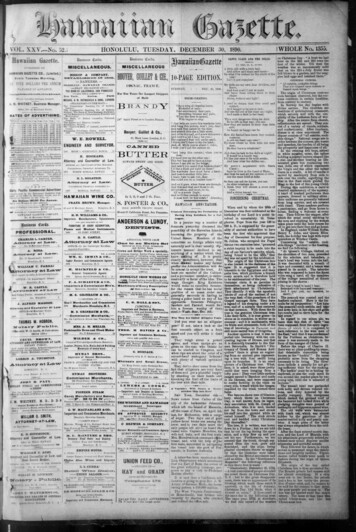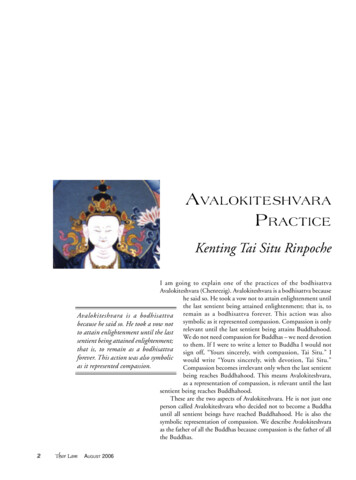
Transcription
AVALOKITESHVARAPRACTICEKenting Tai Situ RinpocheI am going to explain one of the practices of the bodhisattvaAvalokiteshvara (Chenrezig). Avalokiteshvara is a bodhisattva becausehe said so. He took a vow not to attain enlightenment untilthe last sentient being attained enlightenment; that is, toAvalokiteshvara is a bodhisattva remain as a bodhisattva forever. This action was alsobecause he said so. He took a vow not symbolic as it represented compassion. Compassion is onlyto attain enlightenment until the last relevant until the last sentient being attains Buddhahood.We do not need compassion for Buddhas – we need devotionsentient being attained enlightenment;to them. If I were to write a letter to Buddha I would notthat is, to remain as a bodhisattva sign off, “Yours sincerely, with compassion, Tai Situ.” Iforever. This action was also symbolic would write “Yours sincerely, with devotion, Tai Situ.”as it represented compassion.Compassion becomes irrelevant only when the last sentientbeing reaches Buddhahood. This means Avalokiteshvara,as a representation of compassion, is relevant until the lastsentient being reaches Buddhahood.These are the two aspects of Avalokiteshvara. He is not just oneperson called Avalokiteshvara who decided not to become a Buddhauntil all sentient beings have reached Buddhahood. He is also thesymbolic representation of compassion. We describe Avalokiteshvaraas the father of all the Buddhas because compassion is the father of allthe Buddhas.2Thar LamAUGUST 2006
There are many Avalokiteshvara practices: two-armedAvalokiteshvara, four-armed Avalokiteshvara, thousandarmed Avalokiteshvara, red Avalokiteshvara, whiteAvalokiteshvara, and many more. The great goddessesWhite and Green Tara, along with the twenty-one Taras,are manifestations of Avalokiteshvara and WangchukChenpo (Mahashevara, Shiva), the great god ofHinduism, is also described as a manifestation ofAvalokiteshvara. In our prayer we say “Chenrezig tu wangchug lha chenpo,” “The manifestation ofAvalokiteshvara, the great god Shivaji.”The thousand-armed Avalokiteshvara came aboutbecause many eons after taking his vow, through hiswisdom, Avalokiteshvara assessed how many beings hadalready attained Buddhahood and how many were stillsuffering in samsara. The sentient beings suffering insamsara were countless and the beings who had attainedBuddhahood were also countless. The sentient beingssuffering in samsara were hopeless though, and seeingthis Avalokiteshvara became discouraged and almostbroke his vow. Now originally, when he had taken hisvow, he had promised that if he broke his vow his bodywould fall into a thousand pieces so when he becamediscouraged this is exactly what happened, his body brokeinto a thousand pieces.Through the blessings of all the Buddhas andbodhisattvas, however, he was transformed into histhousand-eyed, thousand-armed form. The thousand eyesrepresent a thousand Buddhas, and the thousand armsrepresent a thousand Chakravartins, universal monarchswho are the patrons of the Buddhas. This is the way thethousand-armed Avalokiteshvara manifested.Another time, when Avalokiteshvara again gazed onall sentient beings and saw how many countless sentientbeings were suffering in samsara, he shed two tears. Thesetwo tears transformed into Green and White Tara, twomanifestations of Avalokiteshvara. They vowed to playthe role of enlightened mother to all sentient beings,helping them to attain Buddhahood and fulfillAvalokiteshvara’s original aspiration. Green Tara and thetwenty-one Taras manifest to help sentient beings, inparticular to liberate them from types of fear or aspects ofThar Lam AUGUST 20063
suffering. This is the Anuttarayoga aspect ofAvalokiteshvara.I believe that many people in East Asia considerAvalokiteshvara to have a female form and be white incolor. I can’t be a hundred percent sure but I presume thisis White Tara, a manifestation of Avalokiteshvara. To besure you would have to go to a lineage master of thatparticular practice, scholars and many other people. I amdrawing conclusions here, because I have no authorityand don’t know for sure, but for me this is what KuanYin is, White Tara, Avalokiteshvara in female form.Avalokiteshvara’s practices, as with all dharmapractices, have three parts. The first of these is refuge andbodhichitta. We have to focus on refuge and bodhichittaevery time we practice, otherwise we may forget thepurpose of our practice. To make sure we know clearlywhy we are doing a practice we start by saying the refugeand bodhisattva prayers. These two prayers together makeup four simple sentences. These two sentences are therefuge prayer:Until I reach enlightenment,I take refuge in all the Buddhas,And in the dharma and all the noble sangha.The next two sentences are the bodhichitta prayer:By the merit of accomplishing the six perfections,May I achieve Buddhahood for the benefit of allsentient beings.Bodhichitta is peace. Sometimes I feel peoplemisunderstand, or do not understand clearly, the differencebetween basic compassion and bodhichitta. If you are ableto spend a few hours doing something for somebody youdon’t even know people might call you a bodhisattva. Theymay say, “Oh, he or she is so kind, they are a bodhisattva.”This is not necessarily so. A kind person is not necessarilya bodhisattva. Being kind is very good, being acompassionate person is very good, but it does notnecessarily make us a bodhisattva. A bodhisattva has tobe kind and compassionate for a reason. A bodhisattva iskind and compassionate in that they are working toestablish all beings as Buddhas. In this way bodhichitta isvery specific.As a Vajrayana Buddhist whose ultimate aim is toreach Buddhahood, not just nirvana but Buddhahood,we must have bodhichitta. We cannot attain Buddhahoodunless we wish to attain Buddhahood. We cannot attainit by mistake or accident. It has to happen intentionally.The intention must be to become a Buddha for the benefitof all sentient beings. If I were to wish to become a Buddha4Thar LamAUGUST 2006just for my own reasons, it would never happen. Thisintention would make my Buddhahood limited, private,but Buddhahood cannot be limited. By definition Buddhais limitless. This means that Buddhahood has to beattained by a limitless purpose – the limitless freedomand liberation of limitless sentient beings. Bodhichitta,therefore, must be focused on enlightenment in this way.The next section of the practice is the visualization ofthe four-armed Avalokiteshvara.On the crown of my head and that of all sentientbeings pervading space,On a moon, on a lotus, is a HRI.From the HRI on the lotus appears the Nobleone, Chenrezig.He radiates clear white light.He gazes with compassionate eyes and a loving smile.He has four hands. The first two are joined in prayer.The lower two hold a crystal rosary and white lotus.He is arrayed with silk and jewels.He wears an upper robe of doeskin.His head ornament is Amitabha, Buddha ofBoundless Light.His legs are in the vajra posture.A stainless moon is his backrest.He is the essence of all those in whom we take refuge.Following the refuge and bodhichitta prayer wevisualize Avalokiteshvara. On the crown of our head, andthe heads of all sentient beings pervading space, there restsa white lotus and moon disc. Standing on the moon discis a HRI, a syllable letter: from this HRI comes the noblesupreme Avalokiteshvara. He is luminous white, radiatingfive-colored light and grace. He is smiling charmingly,with compassion, and gazing at sentient beings withcompassionate eyes. He has four arms; the upper two arejoined together and the lower two hold a white lotus andcrystal mala. He is beautifully adorned by precious jewelsand silks. A deerskin that symbolizes compassion covershis upper body, worn over his left shoulder.Some people have a hard time understanding why a
deer skin should represent compassion, but the particulardeer whose skin Avalokiteshvara wears was a bodhisattvamanifesting as a deer who sacrificed his life for the benefitof all sentient beings. Hence this deerskin representscompassion. It is not as if the deer was killed andAvalokiteshvara is now wearing its skin.Avalokiteshvara’s crown jewel is the BuddhaAmitabha. He actually has five crowns representing allfive Buddha families, but on top of these is the BuddhaAmitabha. Avalokiteshvara sits in the vajra asana and astainless moon supports his back. This means there aretwo crystal moon discs in this visualization: one is used asthe seat underneath him and the other behind him as abackrest. Avalokiteshvara, in this basic visualization, isthe essence of all sources of refuge.This is this practice’s main visualization. Followingthis visualization, we praise the Lord Avalokiteshvara:Oh Lord of whitest form, not clothed by any fault,Whose head a perfect Buddha crowns in light,Gazing compassionately on all beings,To you, Chenrezig (Avalokiteshvara), I prostrate.There is no specific visualization that accompanies thispraise; we should maintain the visualization we alreadyhave and mean what we say when we say it. In this prayerwe supplicate the Lord Avalokiteshvara, whose white bodyis not clothed by fault and whose head is adorned by theperfect Buddha Amitabha. Avalokiteshvara looks uponall beings with compassionate eyes. In Tibetan this secondto-last sentence actually contains the Tibetan name ofAvalokiteshvara, Chen-re-zig. Chen is the honorific wordfor eye. Ordinarily we say mik. The two syllables Chen-retogether mean the entire face, or the eye itself. Zig is theverb “to look.” To understand Tibetan syllables and wordsyou have to look at their spelling, not only their sound.The zig here has four letters in Tibetan that make onesyllable and means “to look.” If this syllable were only tocontain the first three of these letters, and not the finalletter “sa,” it would still be pronounced the same but itwound mean tiger or leopard. So here where it says, Tukjay chen gyi dro la zig, “Your compassionate eyes look onall beings,” the chen, “eyes,” and the zig, “look,” are thesame syllables that are in the name Chen-re-zig.Following this there is a longer prayer toAvalokiteshvara:I pray to you, Lama Chenrezig.I pray to you, Yidam Chenrezig.I pray to you, Perfect Noble One Chenrezig.I pray to you, Lord Protector Chenrezig.I pray to you, Lord of Love, Chenrezig.Buddha of Great Compassion, hold me fast inyour compassion.From time without beginning beings have wanderedIn samsara, undergoing unendurable suffering.There is no other refuge but you, Lord Protector!Please bless them that they achieve the omniscientstate of Buddhahood.This prayer starts by supplicating the LamaChenrezig. A lama is a guru. It continues with a prayer tothe Yidam Chenrezig. A yidam is a deity, thesambhogakaya aspect of the Buddha. Then it continueswith a prayer to the Noble Chenrezig, the Lord ProtectorChenrezig and the Lord of Love Chenrezig. These refer tomore specific characteristics of Avalokiteshvara.Up until this point we are asking Avalokiteshvara tobless ourselves and other beings; from here on we makespecific prayers on behalf of the six realms.By the power of accumulating negative karmafrom beginningless time,Sentient beings, through the force of anger, are bornas hell-beingsAnd experience the suffering of heat and cold.May they all be born in your presence, Perfect Deity.OM MANI PEME HUNGThis first prayer is for the sentient beings in the hells.We pray to Avalokiteshvara to help them become free fromthis suffering. This prayer accords with the last syllable ofAvalokiteshvara’s mantra OM MANI PEME HUNG. HUNGrepresents the compassion of Avalokiteshvara that purifiesthe karma of sentient beings committed through anger,and this leads to the liberation of hell-beings from thesuffering of hell. In this prayer we start at the lowest realm,the hell realm represented by HUNG, and work our way throughthe realms represented by ME, PE, NI, MA before reaching thehighest realm, the god realms represented by OM.In this first prayer that relates to HUNG and the hellrealms we reflect that because sentient beings haveaccumulated negative karma since beginningless time, theyare born in hell through the force of anger and experiencethe extreme suffering of heat and cold. We then pray thatthey may be liberated from this suffering by being bornin the presence of the perfect deity, Avalokiteshvara. OMMANI PEME HUNG.By the power of accumulating negative karmafrom beginningless time,Sentient beings, through the force of greed, are bornin the realm of hungry ghostsAnd experience the suffering of hunger and thirst.Thar Lam AUGUST 20065
May they all be born in your perfect realm, the Potala.OM MANI PEME HUNGThis prayer is about those in the preta or hungry ghostrealms. We are not praying to them though, we are prayingfor them – there is a big difference. We do not pray to thehungry ghosts, we pray to Avalokiteshvara for the hungryghosts. These beings, having accumulated negative karmasince beginningless time, are born in this realm throughthe force of greed and experience the suffering of hungerand thirst. We pray that they may be liberated from thissuffering and all be born in Chenrezig’s perfect realm, thePotala. This means we are requesting Chenrezig to liberateall sentient beings from the suffering of the preta realms.OM MANI PEME HUNG.These verses don’t translate very smoothly becauseTibetan and English do not match exactly. In Tibetan,for example, instead of asking someone, “How are you?”we will say, “Cherang kusu depo yin bä?” Cherang means“your,” kusu is the honorific way to say “body,” depo meanscomfortable, yin means are, and bä is a question particle.A direct translation would be, “Your body comfortable,yes?” This shows the difference between the languages andhow when prayers are translated almost word for wordthat they do not sound very smooth.By the power of accumulating negative karmafrom beginningless time,Sentient beings, through the force of stupidity, areborn a
and don’t know for sure, but for me this is what Kuan-Yin is, White Tara, Avalokiteshvara in female form. Avalokiteshvara’s practices, as with all dharma practices, have three parts. The first of these is refuge and bodhichitta. We have to focus on refuge and bodhichitta every time we practice, otherwise we may forget the purpose of our practice. To make sure we know clearly why we are .
